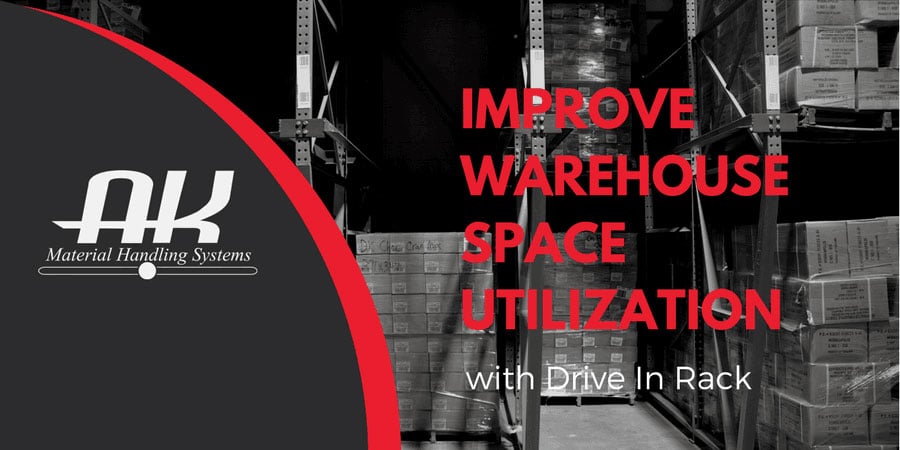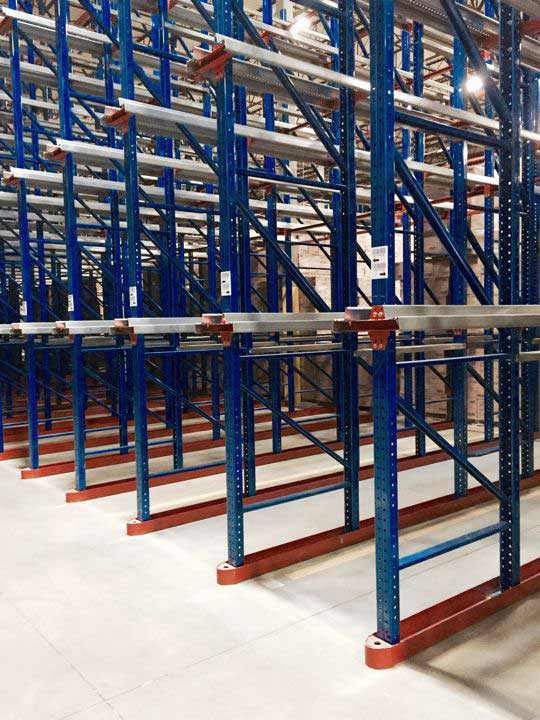
If you’re looking for a pallet racking system that uses first-in, last-out (FILO) order picking and have a low variety of SKUs, drive in racking might be the perfect fit. Drive in racking allows forklifts to drive into the system itself, lowering the number of aisles needed in the warehouse. Unlike selective pallet rack, drive in racking uses upright frames and horizontal loading rails to store pallets. The result is an up to 75% greater pallet storage capacity than selective racking. In drive in pallet rack systems, pallets can be stored up to 10 deep. Because of this and the use of FILO order picking, it’s vital the inventory have relatively few SKUs.
Advantages of Drive In Pallet Racking
For the right business, there are several advantages to using drive in systems. One of these advantages is price. The cost of drive in racking is often lower than that of other engineered storage systems, such as push back rack. Overhead is a priority for almost any company, and saving even a few hundred dollars can impact your warehouse in the long run. Being relatively low cost and improving storage capacity can make drive in pallet rack a boost to the bottom line.
Drive in systems are often, though not always, made using structural steel beams and frames that can better withstand impacts than roll formed steel. Another huge plus to drive in systems is that they create floor space by eliminating aisles. Unlike other systems, pallets are stored back-to-back, freeing up aisle space. This creates floor space which otherwise would be occupied by aisles. This efficiency of space usage is the single most important advantage of drive in pallet rack systems.
Drive in rack systems can be used in a wide variety of storage applications and industries. However, regardless of industry or product type, it’s important to remember that forklift operators won’t have immediate access to the back of the racking. In other words, time-sensitive items or inventory that needs to be stored in a FIFO sequence won’t work well with drive in rack.

For the right business, there are several advantages to using drive in systems. One of these advantages is price. The cost of drive in racking is often lower than that ofother engineeredstorage systems, such as push back rack. Overhead is a priority for almost any company, and saving even a few hundred dollars can impact your warehouse in the long run. Being relatively low cost and improving storage capacity can make drive in pallet rack a boost to the bottom line.
Drive in systems are often, though not always, made using structural steel beams and frames that can better withstand impacts than roll formed steel. Another huge plus to drive in systems is that they create floor space by eliminating aisles. Unlike other systems, pallets are stored back-to-back, freeing up aisle space. This creates floor space which otherwise would be occupied by aisles. This efficiency of space usage is the single most important advantage of drive in pallet rack systems.
Drive in rack systems can be used in a wide variety of storage applications and industries. However, regardless of industry or product type, it’s important to remember that forklift operators won’t have immediate access to the back of the racking. In other words, time-sensitive items or inventory that needs to be stored in a FIFO sequence won’t work well with drive in rack.
Here’s a list of common applications of drive-in systems:
- High-density requirements: Freezer, coolers and all types of expensive storage environments are common environments for drive in racking
- Revenue warehousing: this could be public warehousing, a “3PL,” moving & storage company, or any other type of revenue-based storage business
- “All in, all out:” Much like you find in most produce industry applications is virtually ideal.
- Low SKU counts: Where there are far more pallets than there are SKU’s. “W.I.P” (Work In Process) storage of raw materials is just one example.
- Slow-moving product: Examples include bulk buy materials that will be stored for long time periods and materials that aren’t easily stacked.
- Limited storage space: Because it creates such dense storage, drive in racking may be used in applications in which space is limited.
Wait, What is Drive Through Pallet Racking?
Drive-in and drive-through racking are very similar, as you may have guessed. The standout difference in the design of drive-through rack from drive in rack is that the system is open at both ends, rather than just one. This allows forklifts to drive through the system itself, not just into the system. Earlier we mentioned that drive in systems have a FILO order picking sequence. With drive through this sequence changes to a first-in, first-out (FIFO) system as pallets can be pulled from the other side of the system. Commonly, one side is utilized to load the product, while the other is used to unload the product. Because of this, drive-through systems better accommodate time-sensitive products that drive in systems can’t. A potential drawback to using drive through instead of drive in rack is need for an additional aisle, resulting in less storage space.
Warehouse Safety and Drive In Pallet Rack
With any system, there are safety best practices that come with it. Because the forklifts fully enter drive in systems, rack safety concerns take on more urgency. Forklift operators and warehouse personnel must take extreme caution when using drive in racking, and careful attention should be paid to the condition of the racking. It’s vital in a drive in system for the operator of the forklift to be especially attentive while loading and unloading. Before loading, the forklift should be checked to make sure it’s compatible with the system. Even forklifts that are compatible will usually have very little clearance on either side. Drive in racking can be fairly deep, in which case the forklift operator must slowly and deliberately reverse out of the system. It’s also necessary to conduct regular maintenance checks on the racking to ensure it’s in good condition for the forklifts to enter.
For a primer on how this system works and how it’s utilized, here’s a short clip. This drive-in pallet racking demonstration was taken at our Maple Grove, MN pallet rack quick ship warehouse and shows how to properly load and unload pallets from a drive in system.
Let’s Talk
Ready to get started? Or have questions about any of our products or services? Fill out the form and a representative will contact you promptly.
About AK Material Handling Systems
We deliver value to our customers by providing the absolute best combination of quality products, helpful customer service and competitive pricing. We specialize in warehouse layout & design, pallet rack systems, engineered sales, mezzanines, modular offices and completed turn-key warehouse systems. For more information email us or call (800) 722-5908
Let’s Talk
Ready to get started? Or have questions about any of our products or services? Fill out the form and a representative will contact you promptly.
About AK Material Handling Systems
We deliver value to our customers by providing the absolute best combination of quality products, helpful customer service and competitive pricing. We specialize in warehouse layout & design, pallet rack systems, engineered sales, mezzanines, modular offices and completed turn-key warehouse systems. For more information email us or call (800) 722-5908

